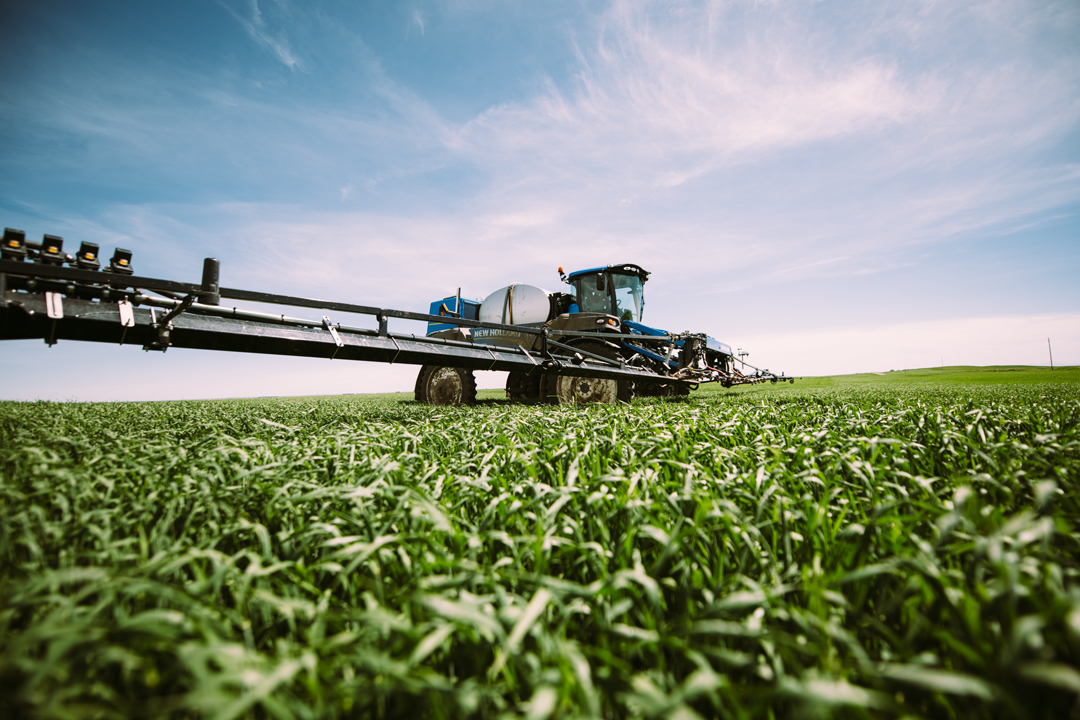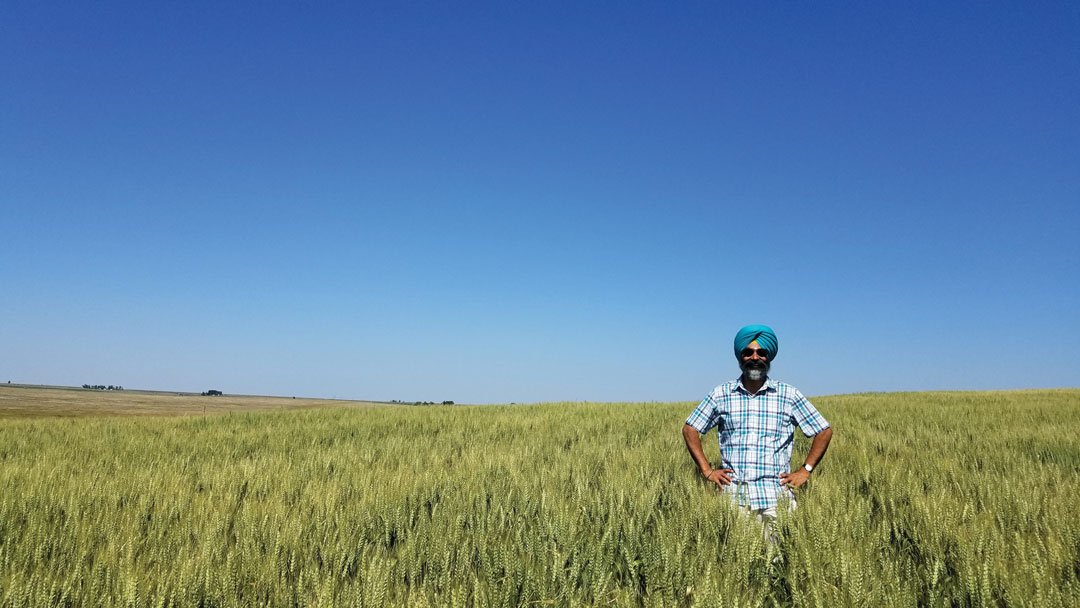LIQUID DIET
BY MELANIE EPP • PHOTO COURTESY OF NICOLE MURRAY PHOTOGRAPHY
A dozen years ago, Devon Walker officially began farming alongside his dad Donald on the family farm in northwest Saskatchewan near the Alberta border. Like many young farmers, Walker was eager to put his stamp on the farm by adopting new management practices he believed would “shed risk.” After evaluating the farm’s fertility plan, he suggested they put partial fertility down at planting and then top up with a foliar application later in the season when the crop needed it most. “Applying foliar is like rubbing a sandwich on your arm when you’re hungry,” advised Donald.
At the time, the young farmer had only a couple years of experience, while his father, a professional agrologist, had decades. Walker took his father’s advice seriously. Foliar fertilization wasn’t going to change the fact the soil and local climate created certain constraints.
Walker’s 3,000-acre farm gets between 100 and 110 frost-free days at best. Come spring, he needs to get into the field as soon as the soil is warm enough and put fertilizer and seed down together to give the crop its best possible chance. “I’ve got limiting factors beyond fertility in my area,” said Walker. Lodging, early frost and snow are bigger hurdles, he added.
“We’re worried about early frost in September. If we pump too much for fertility into our plants, they’re just way too happy, way too green when that September frost hits. And then we’re in trouble.”
THERE’S A RIGHT WAY
Walker isn’t alone in his curiosity about foliar fertilization. As western Canadian farmers gear up for the 2023 growing season, many will evaluate fertility plans and crunch numbers. Low supply, high prices and adverse weather have prompted some to explore the advantages and limitations of foliar applications.
The application of water-soluble nutrients onto plant foliage has been touted as an effective means to alleviate fertility issues and boost yield. Splitting applications helps mitigate fertility costs, especially in regions where crop failure has been on the upswing in recent years.
Its effectiveness is highly dependent on the plant’s ability to absorb nutrients through the surface of its leaves, said Rigas Karamanos, a soil scientist with more than 40 years of experience and a consultant with the research department of the Alberta Wheat and Barley Commissions. Dissolved in water, the nutrients enter the leaf surface via the cuticle or stomata. Penetration depends on environmental factors as well, he said, including temperature, humidity and light intensity.
Even if an application is effective, the quantity of nutrients absorbed at the foliar level comprises a small percentage of the plant’s total needs, said Karamanos. He pointed to a study conducted by University of Manitoba researcher Christine Rawluk in 2000. Its aim was to determine the impact of foliar- and soil-applied urea solutions on the protein and yield of CWRS wheat at flowering. Rawluk determined nitrogen recovery is higher when urea is applied to the soil than when applied to the foliage. When foliar applied, N-labelled urea-N recovery was between 4.5 and 26.7 per cent. On the other hand, when soil applied, nitrogen recovery was between 32.3 and 70.1 per cent.
Despite these findings, Karamanos believes foliar fertilizers have a place. “Foliar fertilization can be very efficient under certain conditions,” he said. “It becomes a desirable option when nutrient uptake from the soil is restricted or soil applications are either limited by cultivation or are not recommended.”
For instance, in hard red spring wheat, post-emergent soil or foliar nitrogen applications can boost protein content. Post-emergent application of nitrogen is common for winter wheat and has been extensively researched on the Prairies. Application of post-emergent nitrogen has also been successfully implemented on irrigated grain crops to manipulate protein content and, in some instances, yield, said Karamanos.
Further studies have indicated split applications of nitrogen boost grain protein concentration, but only when nitrogen deficiencies are corrected at seeding. The practice did not offer an economic advantage, said Karamanos.
The main challenge posed by post-emergent application of phosphorus and potassium is leaf damage. It is extremely difficult to apply adequate nutrients without severely injuring the plant. Using the right nozzles can help minimize crop injury, as can choosing to apply under optimal conditions. Applications at very low rates may also help minimize such damage, though this makes the economic benefit questionable. During a fertilizer shortage, however, a foliar application can be the difference between crop failure and success, said Karamanos. “Most of the time, a foliar application is done in an emergency.”
In Western Canada, foliar applications of micronutrients such as copper and boron are also considered an emergency treatment. It is one of the most effective methods of micronutrient application to direct-seeded crops but also quite costly, which discourages use, said Karamanos. Boron deficiencies are quite rare in Western Canada, but foliar applications are an effective solution should they occur, he added.
Foliar application of copper offers both an agronomic and economic solution when deficiencies arise. However, foliar applications are often not as effective nor a substitute for broadcast and incorporation or banding of copper, especially on severely copper-deficient soils where a foliar application comes too late to help plants overcome deficiency, said Karamanos.
Timing of foliar applications is also crucial, said Karamanos. According to research, a single foliar application when the first node is visible in cereals provides maximum yield. Foliar fertility products should not be mixed with herbicides or pesticides, he added. “With herbicides it’s too early, with pesticides it’s too late,” he said.
OPPORTUNITIES UNDER IRRIGATION
Southern Alberta farmers, especially those in sandy soil areas, are in a unique position when it comes to the use of foliar fertilization as a risk management tool since they can put applications through irrigation systems, said Derek Flad, manager of agronomic solutions for Nutrien Ag Solutions in southern Alberta. He pointed to three major rain events that occurred in the region last summer that washed nitrogen out of the root zone.
“When you’re working under pivot, fertigation is very much a form of risk management,” said Flad. Timing and logistics still come into play, he added. “We can’t put as much nutrition through a sprayer or through a pivot as we can down with seed,” he said. “That’s just not logistically possible. But what this allows us to do is manage the volatility of the growing season.”
Farmers also apply foliar nutrition to remedy post-application “herbicide hangover” in non-herbicide resistant cereals. Flad advises farmers boost nutrition using a nitrogen or phosphorus application to help the plant better metabolize the herbicide. “That’s where I see the value of these products,” he said.
He does note foliar fertilization has limitations, especially in the amount of product you can put down per application. “If your sprayer breaks down, if you have windy conditions, which we do in southern Alberta, your window to apply these products is a lot narrower than it would be with putting it all down with the seed,” said Flad.
Also, if conditions are cold, particularly wet or plants are severely stressed, they will not actively grow and take up nutrients. Under poorer conditions, reduced nutrient uptake is a possibility. “But when it comes to good conditions, I like foliar nutrition as you have the opportunity to maximize yield,” said Flad.
He also approves the foliar application of micronutrients such as copper, but at $20 to $25 per acre per pass including equipment costs, warned it’s an expensive proposition, especially if unwarranted. “We do have some copper deficiency in southern Alberta, but most often it’s an N-P-K limitation, rather than a copper limitation,” he said.
Foliar fertilization does not fit every farm. Flad strongly recommends farmers have their soil tested prior to application. “Which product to apply and when to apply depends so much on the farmer’s land, risk profile and, quite frankly, on yield expectations for that crop.
“When a farmer is spending probably over $100 an acre on fertilizer throughout the growing season, $1 to $2 for a soil test is the best investment they can make at the start of the season, so they know what they’re dealing with.”








Comments